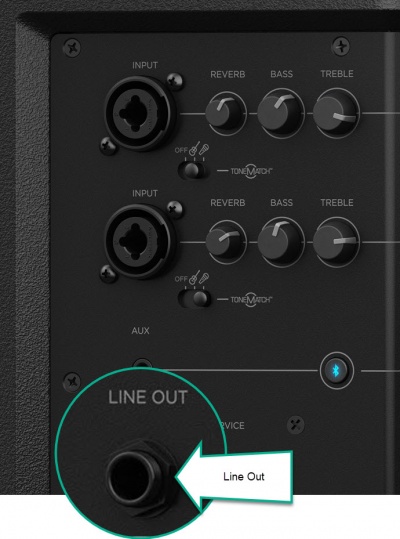Difference between revisions of "S1 Pro Line Out to a Third Party Device"
m (ST moved page S1 Pro to a Third Party Mixer to S1 Pro to a Third Party Device) |
m (added picture) |
||
| Line 1: | Line 1: | ||
| + | [[File:S1 Pro Line Out.jpg|400px|right|S1 Pro system Line Out]] | ||
| + | |||
| + | ; Connect the Line Out from an {{S1}} to the input of another device. | ||
If another device (like a third-party mixer or powered loudspeaker) has a 1/4 inch (6 mm) input, and you don't know if it's balanced or unbalanced, it's usually okay to use a Tip-Sleeve cable. If that connection is balanced, then a Tip-Ring-Sleeve cable is a better choice. If you don't know for sure and don't have time to test, use the Tip-Sleeve cable. | If another device (like a third-party mixer or powered loudspeaker) has a 1/4 inch (6 mm) input, and you don't know if it's balanced or unbalanced, it's usually okay to use a Tip-Sleeve cable. If that connection is balanced, then a Tip-Ring-Sleeve cable is a better choice. If you don't know for sure and don't have time to test, use the Tip-Sleeve cable. | ||
Revision as of 11:35, 19 August 2018
- Connect the Line Out from an S1 Pro System to the input of another device.
If another device (like a third-party mixer or powered loudspeaker) has a 1/4 inch (6 mm) input, and you don't know if it's balanced or unbalanced, it's usually okay to use a Tip-Sleeve cable. If that connection is balanced, then a Tip-Ring-Sleeve cable is a better choice. If you don't know for sure and don't have time to test, use the Tip-Sleeve cable.
Most mixers will accept an unbalanced, line-level device. If you use a Tip-Sleeve cable from the S1 Pro system Line Out, that's what you've got - an unbalance, line-level device.
Fewer mixers will accept a balanced line-level device. If you use a Tip-Ring-Sleeve cable from the S1 Pro system Line Out, then the connection is balanced.
